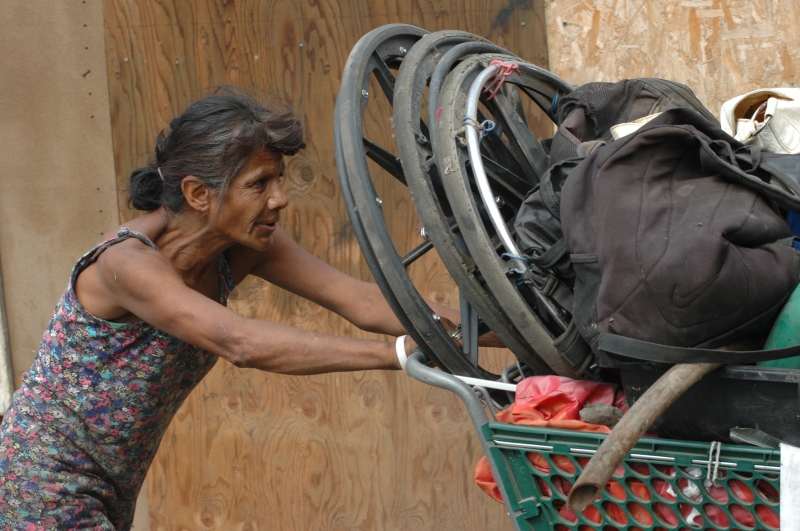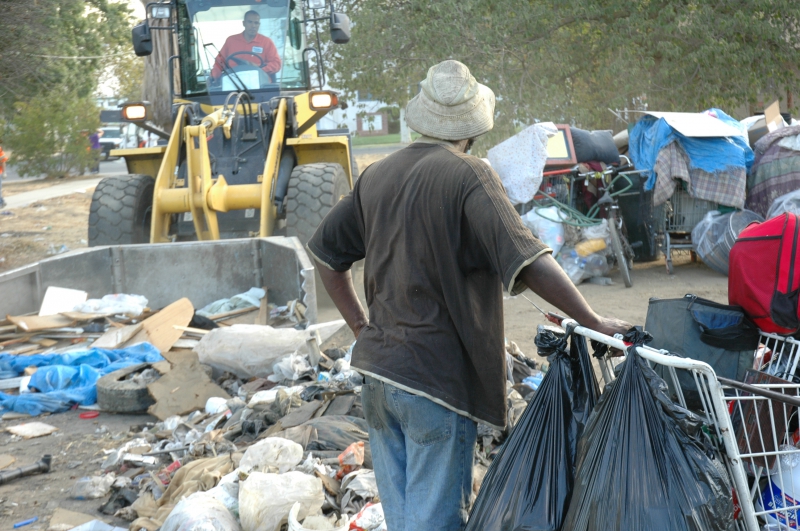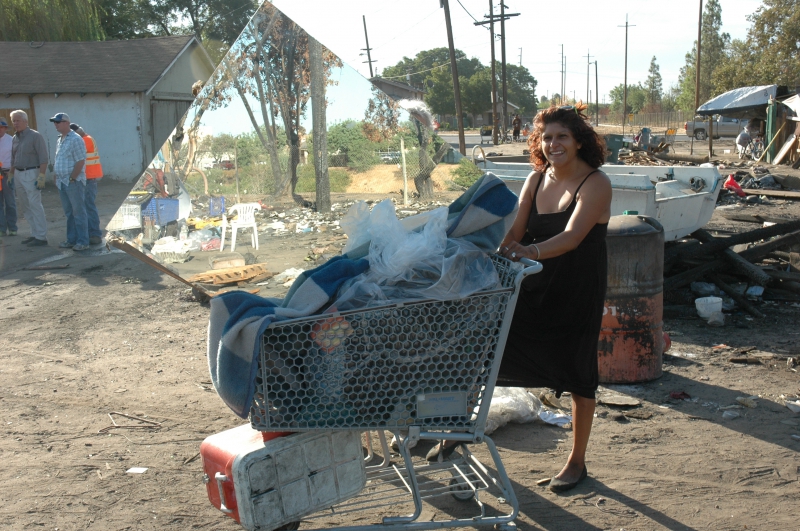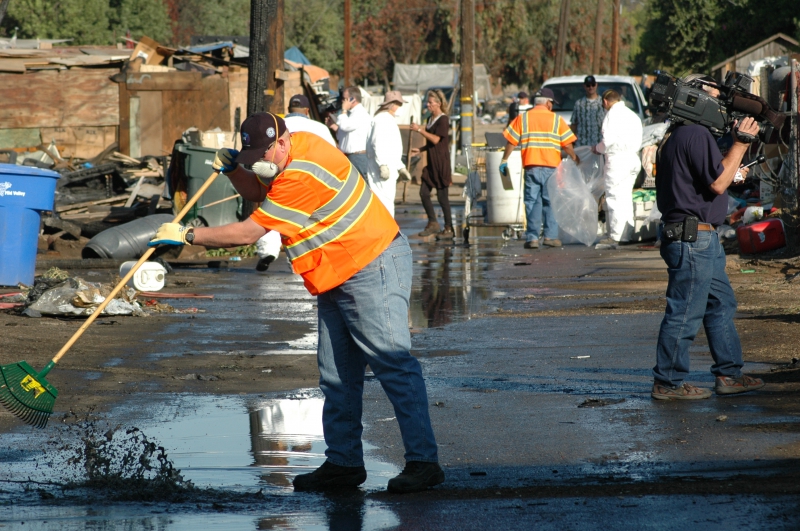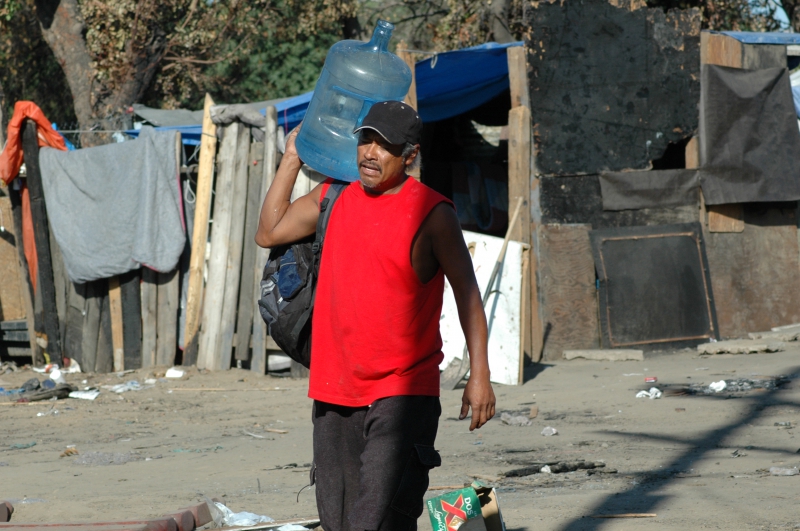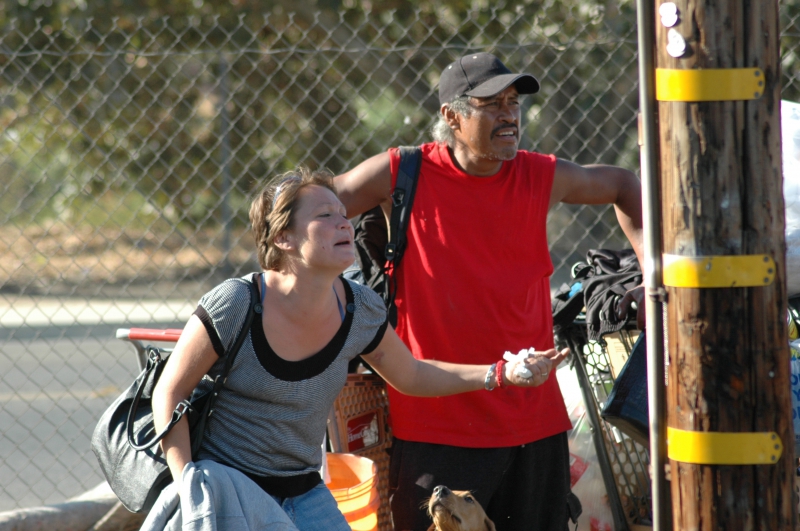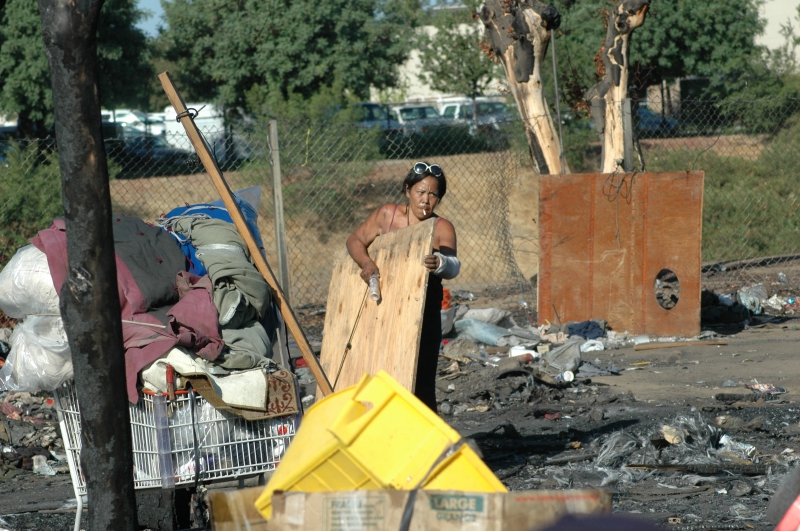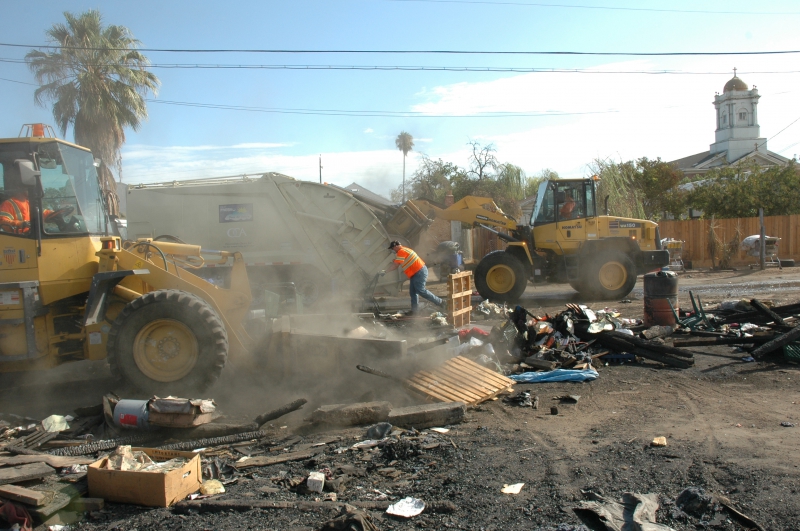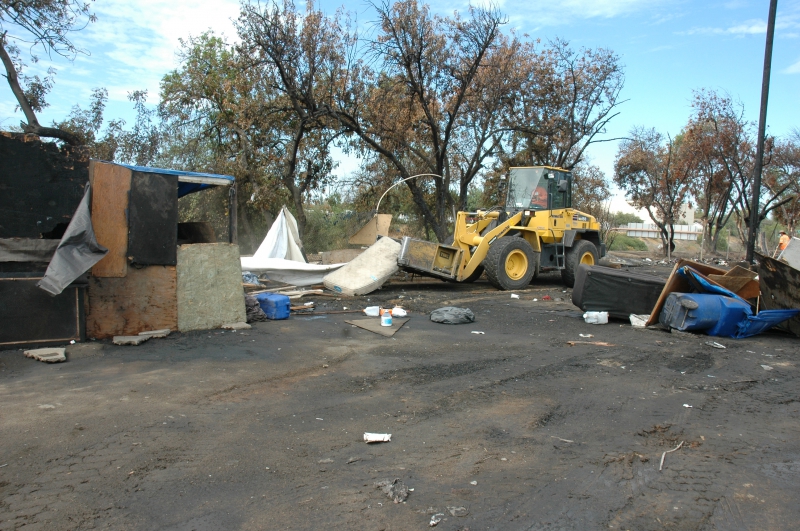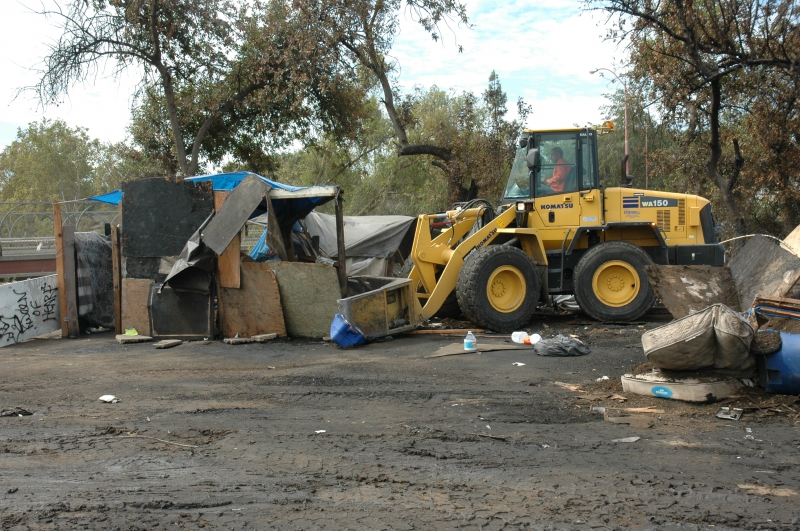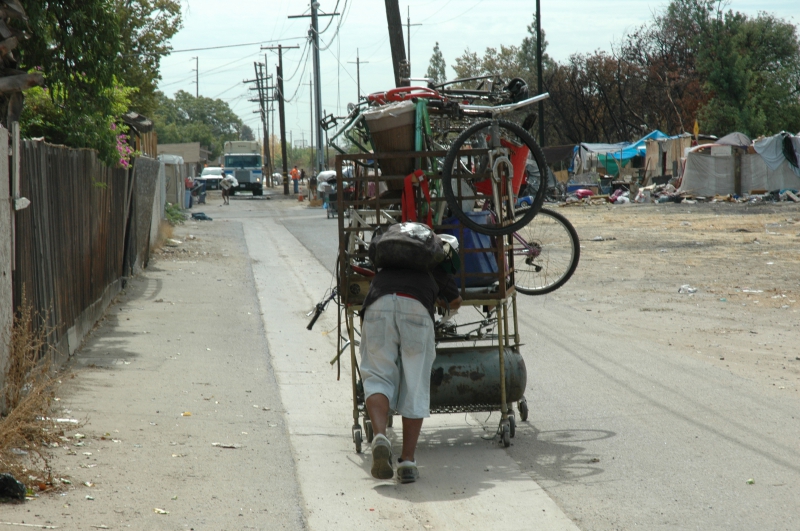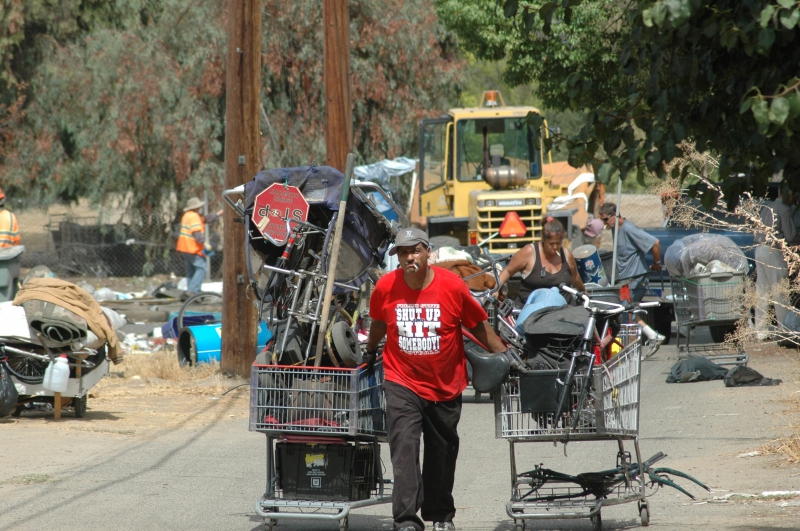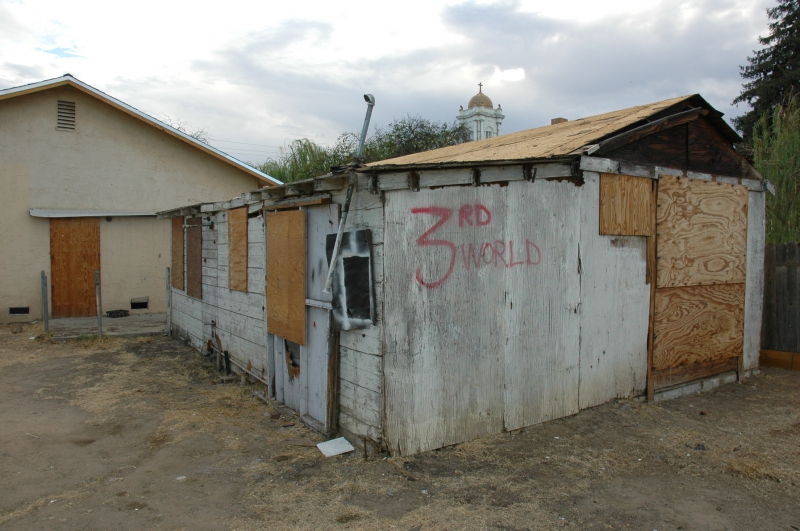Martinez has colluded with police and neighborhood bigots in creating a “no impact” (i.e. no homeless) zone around what I now call the Homeless (Lack of) Shelter Center (since it doesn’t provide shelter to any significant number of homeless people).
She has failed to defend homeless people’s rights, dignity, and safety in the face of intensifying hostility from police and vigilante groups. She is apparently accepting an ID program that will require police checks and plans to use over $100,000 to set up a “security gate”–or so the local Sentinel newspaper claims.
Loisel will be calling in to my Free Radio show Thursday night 9-12 between 6 and 8 PM. The show streams at http://tunein.com/radio/FRSC-
Monterey County, Take A Page from Santa Cruz County
by D.B. Loisel 9-11-13
In life there’s always a back-story, the private story that lies beneath the public story. With homelessness the back-story seems to be either forgotten or ignored in the service of finding a reason for our economic woes, public safety concerns and increased crime. The portrayal of the homeless as the primary cause for economic decline has become popular in cities like Santa Cruz and that is the sad public story. Santa Cruz has identified the homeless as it’s scapegoats, even though it’s irresponsible and inaccurate to blame the homeless for community problems. There is no research that indicates a link between the homeless and increases in crime, decreased public safety or economic hardship. This perception is a local government and media fabrication.
There is a mythological hope these problems would decline, in a cause and effect fashion, with the decline in the homeless population and so the crusade to rid the community of homeless persons is collectively justified. The sad crusade led by the media, local government, small businesses and law enforcement marches forward in a grossly expensive, ill conceived and poorly organized plan to decrease homelessness and thus fix Santa Cruz’s tribulations.
Monterey County officials are beginning to consider how to best manage the homeless in their community. The City of Santa Cruz, with it’s chronic and significantly higher homeless population appears to be at a place of unmanageable frustration with their ability to manage the homeless. The City of Santa Cruz, apparently believing they are replete of options, has initiated taking careless punitive measures against the homeless.
As the economy continues to meander along, Santa Cruz businesses pressure the City council to purge areas of commerce, such as retail stores, small businesses, restaurants and coffee shops, of the “scourge” of the homeless. It seems the homeless are considered a nuisance and drive patrons away. Despite the fact there isn’t any evidence that homeless folks negatively impact local economies, the pervasive belief persists that businesses are adversely affected.
Recently it seems this belief was reflected in the Salinas restaurant owner who nearly beat to death a homeless man who was spending too much time near his restaurant and received a nine year prison sentence for this act of violence (I purposely avoided using the pejorative term “loitering” – when a homeless person stays awhile in a park it’s called “loitering,” when a family stays awhile in a park it’s called a “picnic”). Unsure of whether to take a compassionate approach or a law-enforcement no sit no sleep protect the asphalt and medians approach, Monterey County is currently contemplating what direction to take.
In truth, we can’t even pinpoint why people become homeless or why they stay homeless, let alone estimate their impact on local economies. The tendency is to move forward with spit and vinegar to address and eliminate the homeless scourge.
This gung ho approach often leads to disaster and occurs when public policy is dictated by passion and emotion rather than sound research. When this occurs the potential for misguided decisions increases exponentially, often resulting in unanticipated human suffering. In the absence of sound research, extremely careful consideration needs to be given when leaders chart the direction of community public policy.
A study conducted by UC Berkeley regarding the homeless suggests, “no one believes there is a simple, single cause. Explanations fall into two main categories. One puts primary emphasis on the debilitating personal attributes of many of the homeless—alcoholism, crack cocaine addiction, and personality disorders—and the changes in social policy toward these illnesses.
Rapidly rising rents, rapidly declining numbers of low-income rental units, and deceleration in federal housing programs are noted but are not thought to be central. The other emphasizes the economics of the low- rent housing market while acknowledging the many debilitating personal attributes of many of the homeless. Neither camp denies the importance of making more housing accessible to the poor.” Befuddling.
So the front story is that personal attributes and the high cost of housing are the primary causes of homelessness, the back story is much darker and painful. The life histories of homeless persons reveal common shared experiences, including violent victimization, that contribute to their becoming homeless. A Toronto study of homeless persons found that 49% of women and 16% of men experienced childhood sexual abuse compared with rates of 13% and 4% in the general population. High levels of family violence, lack of care, and sexual abuse are common in the histories of homeless persons, suggesting these are also contributing factors.
A history of family violence also predicted failure to exit homelessness. The quandary of the homeless: mental illness, high rent, drug addiction, and victimization as a child. These are the folks prohibited from laying down on sidewalks and medians, and this is the man that was nearly beat to death in Salinas for “loitering.” We are generous with ourselves when we perceive ourselves as an educated society.
In times of panic, communities try to find someone or something to blame for their troubles, and the homeless are an easy target. I think it’s important to
mention the recession of 2008 wreaked havoc on business in both areas with homeless persons and without homeless persons.
The 2008 economic collapse, in hindsight, was clearly a result of the deregulation of the banking institutions, mass-incarceration of non-violent drug offenders, corporate greed, the war in Iraq and the sub-prime mortgage scandal, all subsets of the Bush neo-con experiment. These problems were a trickle down result of the Bush mega-ignoramuses’, and we are still trying to recover. It’s easy to understand communities like Santa Cruz, feeling disempowered and frightened, trying to understand why their businesses have failed, would blame the homeless. Santa Cruz has sought to control the homeless population as a means to return their sense of control over their dim economic circumstances.
The immediacy and visibility of the homeless population breeds contempt. It’s a lot easier to target what’s presently visible than an abstract and infinitely complex federal monetary system based of obfuscation and deception. Corporations spend a lot of money on public relations. In other words, it’s hard for people to connect the financial anxiety they experience to derivatives but it’s easy to connect it to a dirty person sitting in front of a Starbucks asking for spare change.
Studies show that indoor and outdoor substance use occurs at about the same rate, yet for obvious reasons outdoor substance users are disproportionally represented in the legal system, thus it’s easy to focus on homeless substance use. Another angle Santa Cruz has taken to marginalize the homeless is to portray homeless substance use, particularly IV substance use, as a major public safety hazard. Through inaccurate media “exposés,” the homeless are depicted as miscreants wandering aimlessly leaking disease infected hypodermic needles for children to step on. This portrayal is at best completely irresponsible journalism and at worst a despicable willing misrepresentation of the facts.
The odds of actually being infected by any disease by stepping on a hypodermic needle are less than microscopic (the Center for Disease Control states that it is extraordinarily rare that HIV or Hepatitis is transmitted by a needle-stick injury by stepping on a needle outside a health care setting). This frenzied non-sense is akin to other completely false fear provoking media fabrications such as these gems: killer bees, weapons of mass destruction, Halloween razor blades in apples and the crack baby “epidemic”. An off shoot of this portrayal is that needle exchange programs, which radically reduce the number of needles that are irresponsibly tossed, are under attack as well.
Another wrinkle on the homeless back-story is that permanent, safe housing is totally inaccessible to the homeless. I recently moved from a small but functional studio apartment to a larger more lavish apartment with a fireplace (it’s good to be housed on those rainy winter nights). The move cost me $2,330 dollars in first and last months rent and the cable box. The steps to finding and obtaining an apartment are daunting even for the employed and housed person. For those who haven’t attempted to move lately here’s the drill:
Find a place on Craigslist (which means access to a computer and the internet), fill out the credit application (and pay the $25.00 non-refundable fee), provide a valid California ID, provide a mailing address, get a bank account, explain any negative credit issues, explain any past legal matters, provide three references, show your work history, provide your work number to verify employment, provide a phone number, buy pots, pans, utensils, cleaning supplies, some food, a bed, blankets, sheets and stay sober. For the homeless the housing system is exclusive, making the transition from homeless to housed essentially impossible.
It seems that the City of Santa Cruz has decided the best way to handle their homeless predicament is by bullying through the use of extraordinary restrictive “safety” ordinances. Groups with names like Take Back Santa Cruz [TBSC] have an oddly combative tone and the momentum seems to be towards aggression. The over-zealous public safety laws seem to have led to law enforcement slipping its leash. This is evidenced by the Youtube video taken by Brent Adams on April 22, 2013 of a homeless man being thrown to the ground by law enforcement for public intoxication.
Although focusing on the homeless as a root problem sooths public fears, the reality is that Santa Cruz is not going to ordinance, citation or incarcerate its way out of its homeless dilemma. America has already tried that approach with the war on drugs and now we’re left with the highest rate of incarceration per capita than any other developed country and a nearly bankrupted State of California. Public policy that attempts to use law enforcement as the means to force the homeless out of their community will never work because people who have nothing to lose have nothing to lose.
When economic leverage fails the only option left is using violence and Santa Cruz has taken the low road. Santa Cruz’ strategy is to choke the homeless out of their community by appealing to the societies worst fears by the intentional marketing of the homeless person as a menacing, dangerous, drug addicted, filthy creatures with no redemptive qualities. Society makes obtaining private space for these folks nearly impossible, and yet concurrently and systematically closes down public space for those who have no private space.
Homeless concentrations are often explained by the “magnet theory of homelessness,” that providing services is an enticement to the homeless and draws them into communities that offer an elevated level of social services.
This theory suggests that providing less rather than more services to the homeless will reduce homelessness in a geographic area. I don’t believe this is true, or if it is true only it’s an added benefit to the four fundamental reasons why Santa Cruz has a disproportionately high level of homelessness.
The first reason is there is the easy availability of drugs, and people do drugs, and that is a fact. No matter what a person’s station in life is, reality is that people like to, at times, alter their natural state of consciousness and the homeless are no different. Some people prefer an altered state of consciousness and can’t stop themselves – we call this addiction. We don’t have a drug problem among the homeless, we have a drug problem among Americans, and the homeless are part of America. Santa Cruz has a high availability of drugs, and this keeps homeless persons anchored.
The second reason is that Santa Cruz it has an established homeless community. People are social organisms, and the homeless are no different. For those who cannot negotiate the barriers to finding permanent housing, they will seek out, find and partner with like persons. The third is the climate and scenery in Santa Cruz are distinct and attractive, the same features that residents enjoy, the homeless enjoy too. This reality contradicts our unspoken belief the homeless are emotionless, unmoved by art, beauty, relationships, human touch.
Shocking, as it may seem, homeless persons enjoy living in a beach community just as much as everyone else. Santa Cruz has 262 sunny days per year. If you want to know why the homeless live in Santa Cruz, then ask yourself why anyone lives in Santa Cruz – it’s gorgeous, “hippy-esk,” mild, quaint, temperate, easy to breath. Everybody wants to live in Santa Cruz. The fourth reason is there is easy access to areas of foot traffic and commerce. The homeless need money, even those who receive benefits from the government, and panhandling is the best and often the only way the homeless can get cash.
Another angle that Santa Cruz has adopted to justify the implementation of impotent ordinances is the casting of the homeless as a public safety threat. The creation of the Public Safety Citizens Task Force by its name alone indicts the homeless as a threat to housed persons. There is absolutely no research that supports this myth.
The homeless are simply not a public safety threat. Homeless persons tend to not perpetrate violence or any other imposition on non-homeless persons, other than asking for change. The homeless have higher rates of legal issues because they tend to acquire nuisance violations, such as loitering, public intoxication, petty theft, etc. Statistically, the homeless are no more prone to commit violent crime than a non-homeless person.
The overwhelming evidence is that violent homeless crime is almost always perpetrated against other homeless persons. My observation is that inter-homeless crimes occur and go unreported because the homeless are forced into isolated areas where law enforcement is unlikely to patrol. Rape is an on-going problem among the homeless so women involuntary partner with males solely for the reason of protection in exchange for providing these “protectors” sexual access.
The reality is the homeless are not going to leave our communities, the economic impossibility of the homeless procuring housing ensures this. Unless America decides to seriously commit to providing low and no income housing the homeless, without discriminating against people who choose to use substances or have criminal records, they will be will be inextricably embedded and woven into our communities.
With this in mind, we need to accept our responsibility in the homeless riddle. Homeless encampments are unsanitary because there’s no running water, no sewage system, no trash pickup. The homeless urinate and defecate in public because there are no bathrooms available. The homeless use drugs publically because there is no safe place for them to use drugs. The homeless sleep and sit on sidewalks, because there is no other safe place to sleep or sit. If the community wants the homeless to be clean, provide them with showers, and if the community wants them to wear clean clothes, provide them with laundry facilities.
People aren’t homeless; they suffer from a homeless condition. To say people are homeless is like saying that people suffering from cancer are cancer.
Homelessness doesn’t define the entirety of a person, it’s a part of a person’s story. A person suffering from homelessness has the same hopes, dreams, passions, interests, feelings and curiosity that we all have. The homeless are not soulless reptilian creatures wandering zombie-like among the living (a.k.a. – housed persons). They are us. We rob these individuals of dignity when we narrowly define them according to their living situation. Dehumanization is the first step to marginalizing a population and stereotyping is the second – we label the homeless as lazy, mentally ill, drug addicts, exploitive, violent, etc. Apparently there is a push in Santa Cruz to force the homeless to carry I.D. cards, which is eerily analogous to having a number tattooed on a wrist and would only further widen the divide. A civilized society includes all its citizens, not just those who happen to have the good fortune to be housed.
Monterey County should make a close study of Santa Cruz and with any luck realize its the attributes of Santa Cruz that draw and keep the homeless there. The hundreds of thousands of dollars spent on hiring private security, handing out nuisance tickets (which will never be paid and only creates more barriers to housing for the homeless), incarceration, leveling heavy handed law enforcement which leads to exorbitant law suites is wasted money. There is no return on investment in trying to force the homeless out and their strategy isn’t working.
Monterey should look closely at the decisions it makes and be prudent as they move forward with creating compassionate effective public policy regarding the homeless.

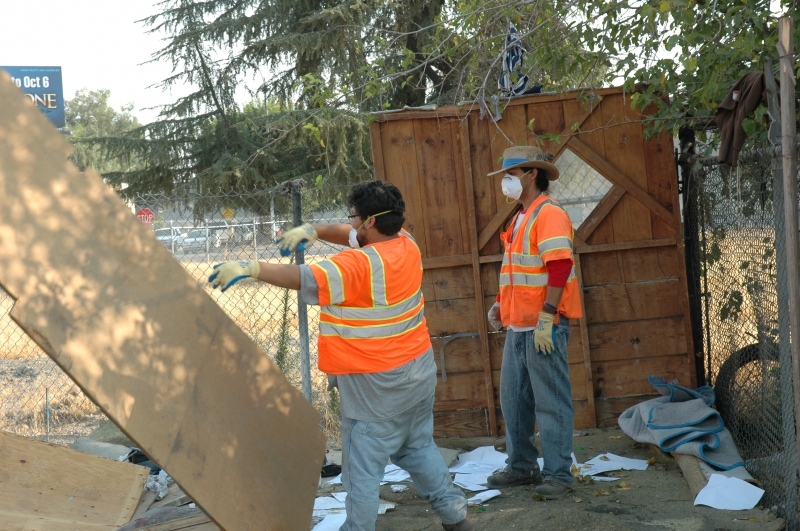
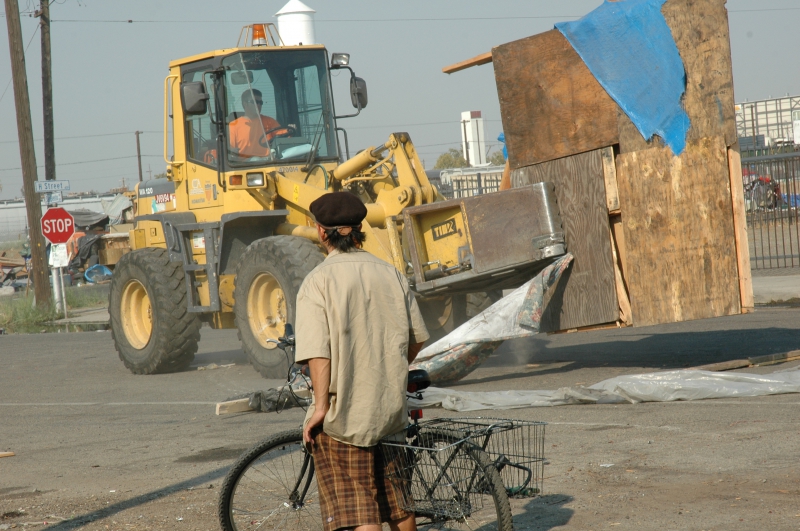
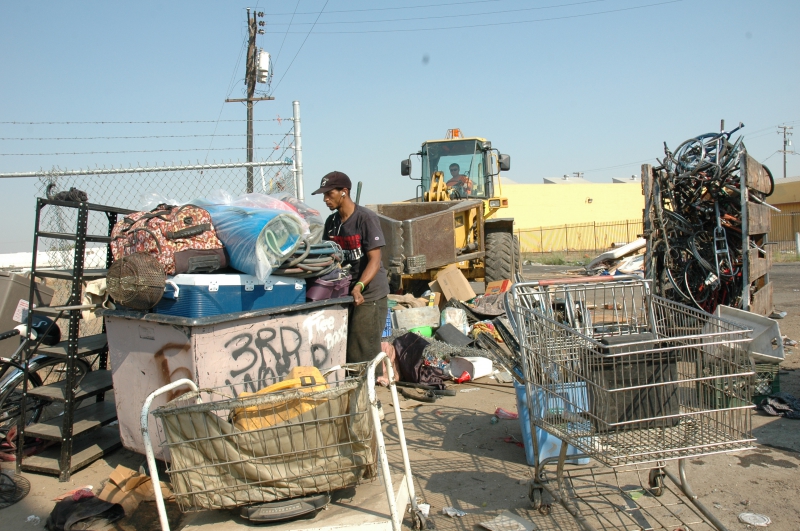
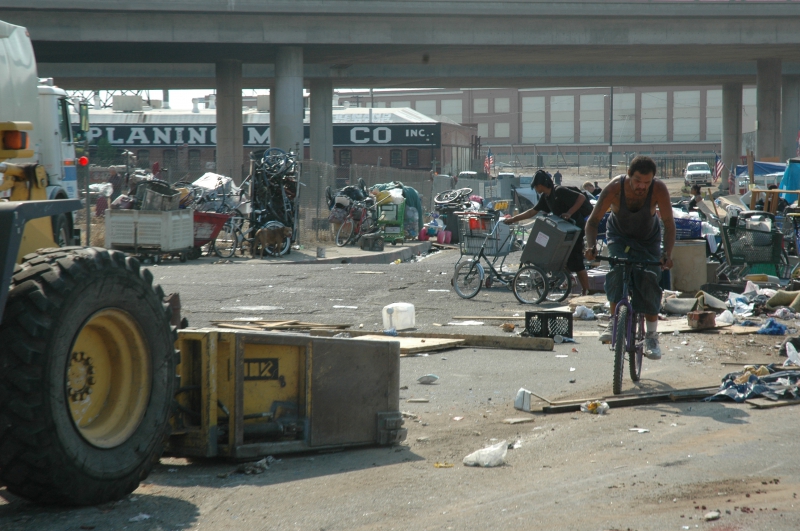
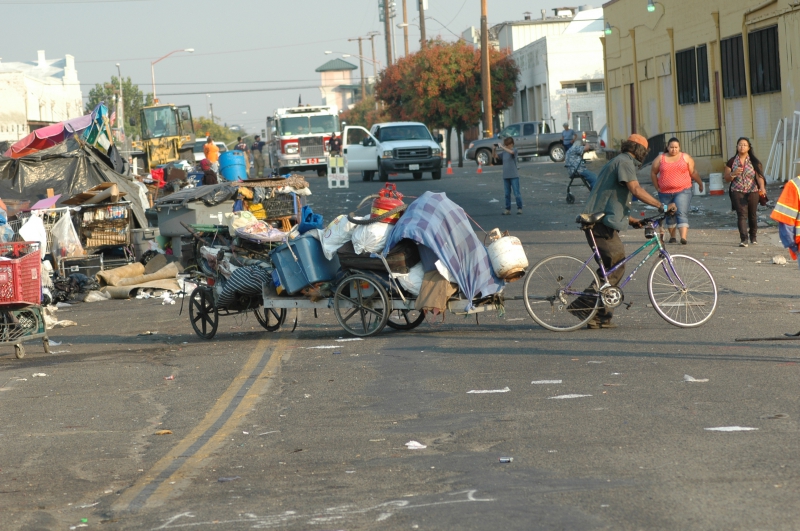
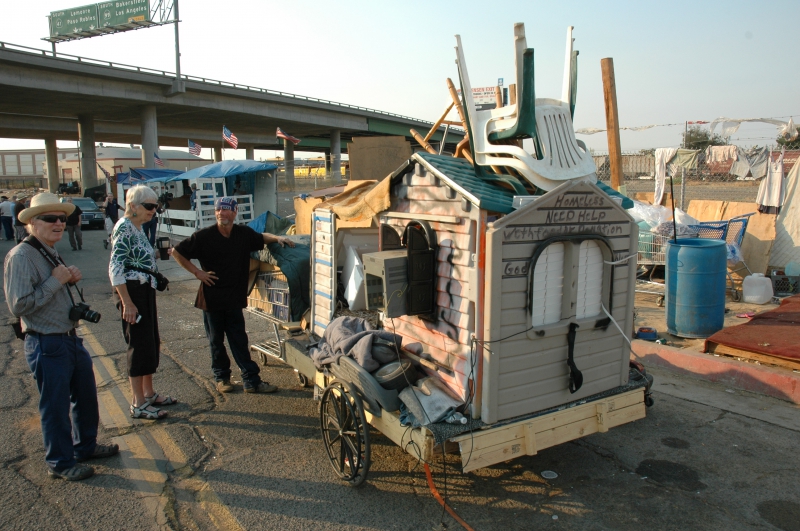
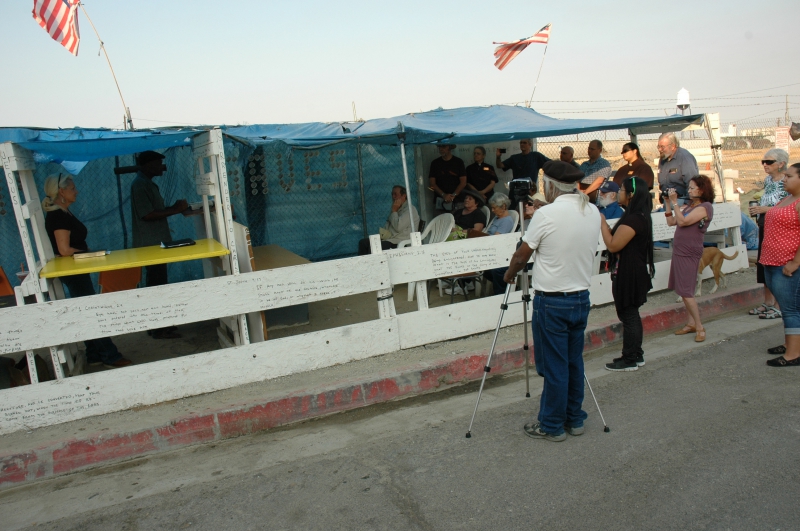

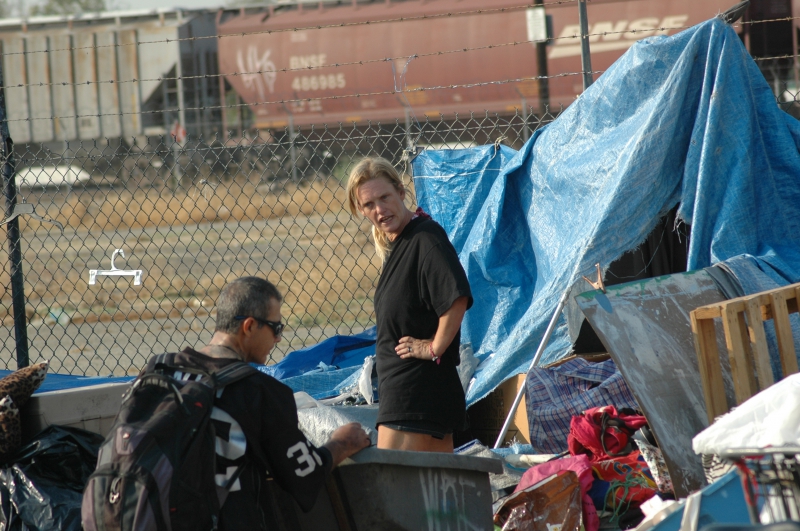
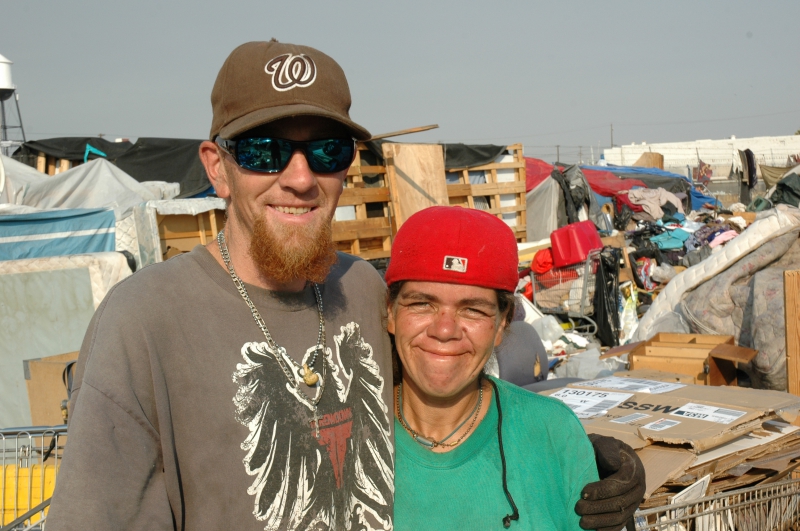
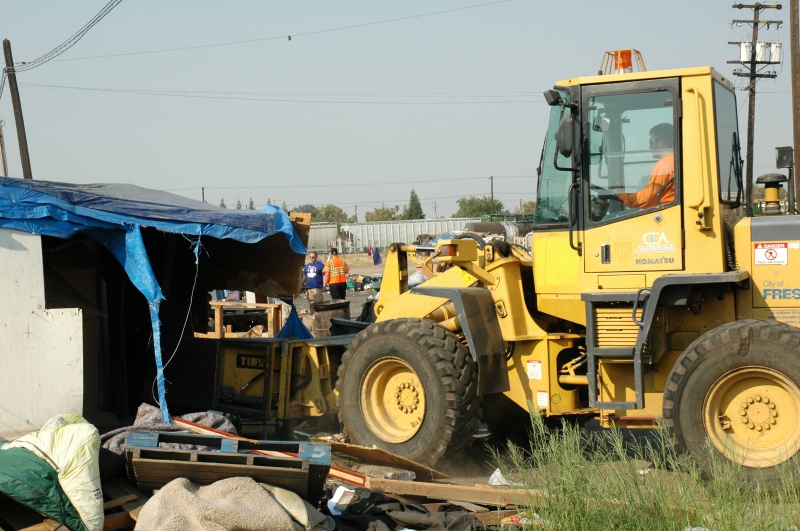
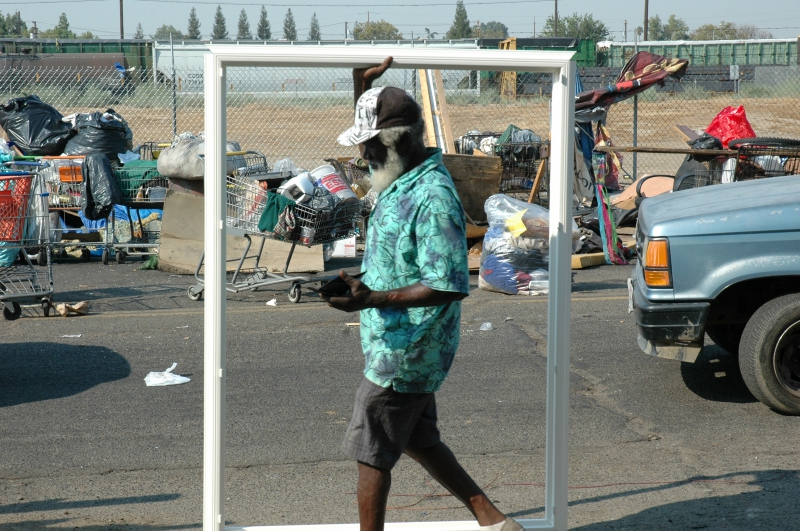
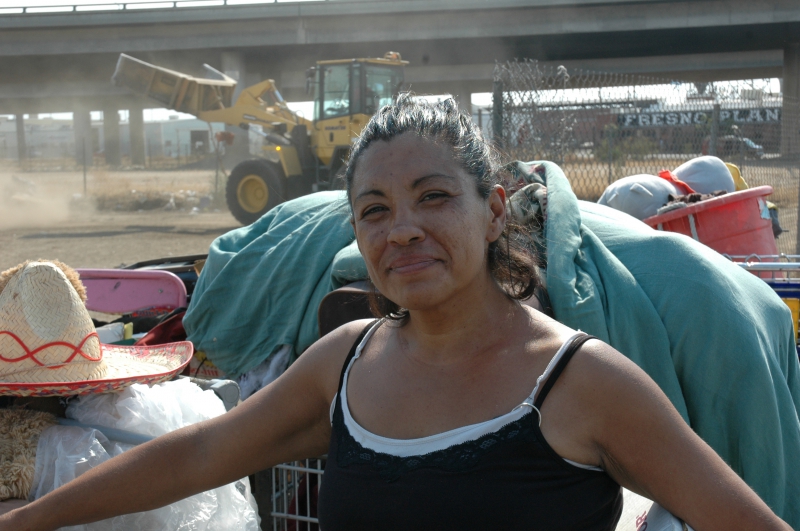
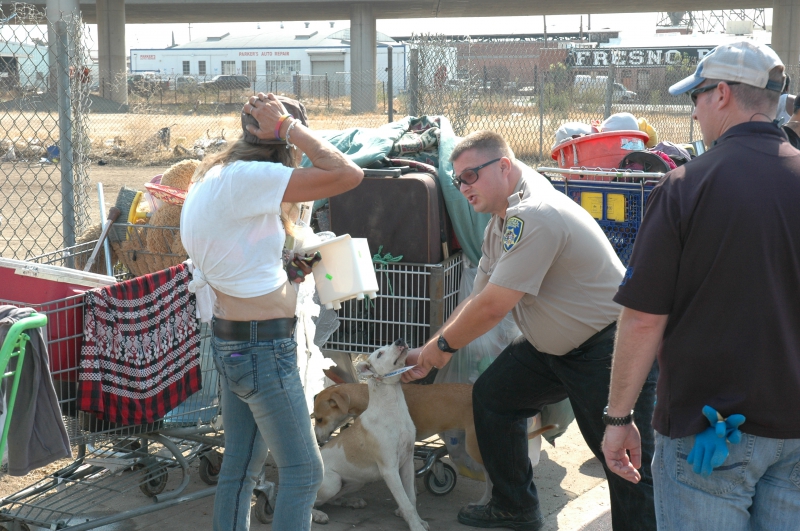
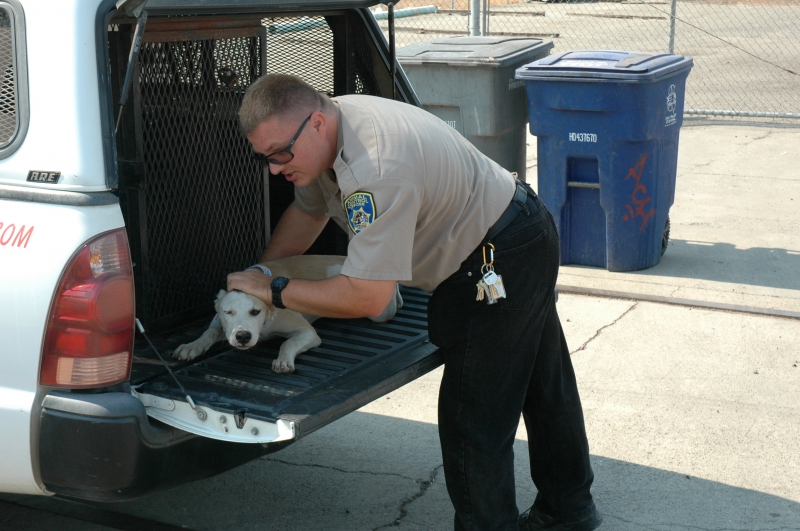







 The author, Jessie Speer (center), with Ray Polk (left) and Larry Collins (right) at the H street homeless encampment, which the City of Fresno plans to bulldoze on Sept. 9.
The author, Jessie Speer (center), with Ray Polk (left) and Larry Collins (right) at the H street homeless encampment, which the City of Fresno plans to bulldoze on Sept. 9.
 The City of Fresno destroyed Yellow Feather’s shelter and confiscated her property. She now sleeps on the sidewalk near the Poverello House.
The City of Fresno destroyed Yellow Feather’s shelter and confiscated her property. She now sleeps on the sidewalk near the Poverello House.
 Rev. Dr. Chris Breedlove of College Community Congregational spoke at the press conference organized by homeless advocates
Rev. Dr. Chris Breedlove of College Community Congregational spoke at the press conference organized by homeless advocates
